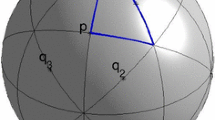Abstract
The aim of the present paper is to study the periodic orbits of a rigid body with a fixed point and quasi-spherical shape under the effect of a Newtonian force field given by different small potentials. For studying these periodic orbits, we shall use averaging theory. Moreover, we provide information on the \(\mathcal{C}^{1}\)-integrability of these motions.
Similar content being viewed by others
References
Abraham, R., Marsden, J.E.: Foundations of Mechanics. Benjamin, Reading (1978)
Birtea, P., Caşu, I., Ratiu, T.S., Turhan, M.: Stability of equilibria for the so(4) free rigid body. J. Nonlinear Sci. 22, 187–212 (2012)
Borisov, A.V., Mamaev, I.S.: Dynamics of the Rigid Body. RCD, Izhevsk (2001)
Buica, A., Llibre, J.: Averaging methods for finding periodic orbits via Brouwer degree. Bull. Sci. Math. 128, 7–22 (2004)
Jiménez–Lara, L., Llibre, J.: Periodic orbits and non-integrability of Henon–Heiles system. J. Phys. A, Math. Gen. 44, 205103 (2011)
Jiménez–Lara, L., Llibre, J.: Periodic orbits and non-integrability of generalized classical Yang–Mills Hamiltonian system. J. Math. Phys. 52, 032901 (2011)
Kinoshita, H.: First order perturbations of the two finite body problem. Publ. Astron. Soc. Jpn. 24, 423–457 (1972)
Leimanis, E.: The General Problem of the Motion of Coupled Rigid Bodies About a Fixed Point. Springer, Berlin (1965)
Llibre, J.: Averaging theory and limit cycles for quadratic systems. Rad. Mat. 11, 215–228 (2002)
Várkonyi, P.L., Domokos, G.: Static equilibria of rigid bodies: dice, pebbles, and the Poincaré–Hopf theorem. J. Nonlinear Sci. 16, 255–281 (2006)
Verhulst, F.: Nonlinear Differential Equations and Dynamical Systems. Universitext. Springer, Berlin (1991)
Acknowledgements
The first and third authors were partially supported by MINECO/FEDER grant number MTM2011-22587. The second author was partially supported by MICINN/FEDER grant number MTM2008-03437, ICREA Academia, AGAUR grant number 2009SGR 410, and FP7-PEOPLE-2012-IRSES 316338 and 318999.
Author information
Authors and Affiliations
Corresponding author
Appendix
Appendix
Now we shall present the basic results from averaging theory that we need for proving the results of this paper.
The next theorem provides a first- and second-order approximation for the periodic solutions of a periodic differential system; for the proof, see Theorems 11.5 and 11.6 of Verhulst [4, 11], and [9].
Consider the differential equation
with \(x\in D\subset\mathbb{R}^{n}, t\geq0\). Moreover, we assume that both F 1(t,x) and F 2(t,x) are T periodic in t. Separately, we consider in D the averaged differential equation
where

Under certain conditions, equilibrium solutions of the averaged equation turn out to correspond with T-periodic solutions of Eq. (8).
Theorem 5
Consider the two initial value problems (7) and (8). Suppose:
-
(i)
F 1, its Jacobian ∂F 1/∂x, its Hessian ∂ 2 F 1/∂x 2, F 2 and its Jacobian ∂F 2/∂x are defined, continuous, and bounded by an independent constant ε in [0,∞)×D and ε∈(0,ε 0].
-
(ii)
F 1 and F 2 are T-periodic in t (T independent of ε).
-
(iii)
y(t) belongs to Ω on the interval of time [0,1/ε].
Then the following statements hold.
-
(a)
For t∈[1,ε] we have that x(t)−y(t)=O(ε), as ε→0.
-
(b)
If p is a singular point of the averaged equation (8) and
$$\det \biggl( \frac{\partial(f_{1}+\varepsilon f_{2})}{\partial y} \biggr) \bigg \vert _{\mathrm{y}=p}\neq0, $$then there exists a T-periodic solution φ(t,ε) of Eq. (7), which is close to p such that φ(0,ε)→p as ε→0.
-
(c)
The stability or instability of the limit cycle φ(t,ε) is given by the stability or instability of the singular point p of the averaged system (8). In fact, the singular point p has the stability behavior of the Poincaré map associated to the limit cycle φ(t,ε).
Rights and permissions
About this article
Cite this article
Guirao, J.L.G., Llibre, J. & Vera, J.A. On the dynamics of the rigid body with a fixed point: periodic orbits and integrability. Nonlinear Dyn 74, 327–333 (2013). https://doi.org/10.1007/s11071-013-0972-y
Received:
Accepted:
Published:
Issue Date:
DOI: https://doi.org/10.1007/s11071-013-0972-y



